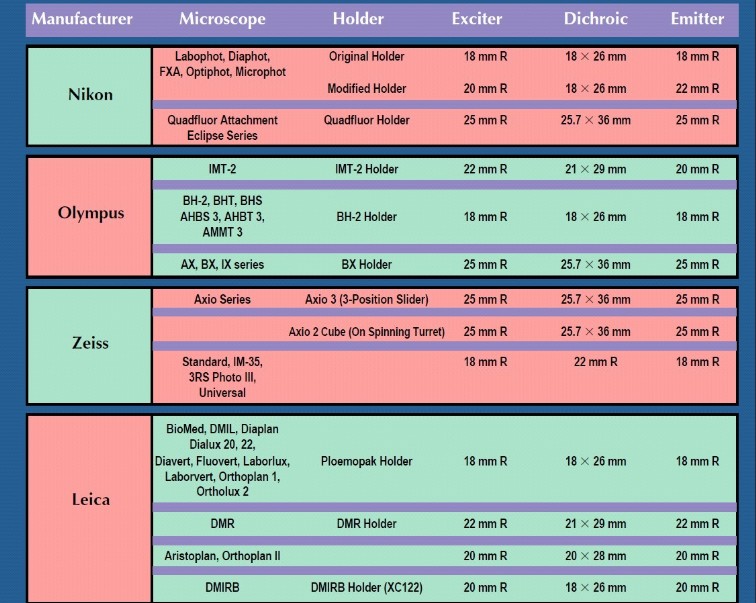www.fluorescencemicroscopy.it
Main menu:
- Home Page
- Microscopes
- Fluorescence
- Description
- Diascopy
- Epi-Fluoresc.
- Illumination
- Installing and Aligning a Mercury Lamp
- Fluorocromes
- Tables of Fluorocromes
- The Fading
- Wavelengths
- Properties
- % of transmission
- Types of filters
- Overlapping Spectra
- Intensity
- Image acquisition
- The Filter's set
- The Filters
- Fluorochrome's praparation
- Sample's preparations
- Fluorescence Sample
- Cytochemical Fluorescence
- Intrinsic Fluorescence
- Gallery
- Phase Contrast
- Polarization
- Darkfield
- DIC
- COL
- Rheinberg
- Brightfield
Types of filters
Fluorescence
Type of Fluorescence filters
The primary element of filtering in a epifluorescence microscope is the set of three filters housed in a block filter or a filter slide: the excitation filter, the emission filter and the dichroic beamsplitter.

Figure 7: set of "ideal" filters for fluorescence, such as an exciter, dichroic and emitter.
An example of absorption (excitation) and emission spectrum superimposed
The excitation filter (also called the exciter) transmits only those wavelengths of light that excite efficiently a specific stain (dye). In the past they were mainly used filters such as "short-pass" filters, now are used almost exclusively of type "band-pass". The emission filter (barrier filter or emitter) attenuates all light transmitted by the excitation filter and, efficiently and selectively, transmits the fluorescence emitted from the sample. This light is always of longer wavelength than the excitation. The emission filters can be either "band-pass" or "long-pass". The dichroic beamsplitter filter is a thin sheet of glass coated with a fixed angle of 45 degrees in the optical path of the microscope. This coating has the unique ability to reflect a wavelength, the excitation light, and transmit a different wavelength, the fluorescence emitted. Today, the dichroic filters can reflect more than 90% of the excitation light and transmit about 90% of the light emission, compared to the previous half-silvered mirror gray filters that reflected and transmitted 50% of the light arriving at an efficiency of only 25%.The spectral characteristics of a particular dye, can be superimposed with the spectral profile of a set of filters for fluorescence at last to drive in choosing of the most appropriate set of filters for a particular application. Figure 7 shows the spectral profile of a set "ideal" filters used to excite a given fluorophore and capture the emitted light. As you can see, the excitation filter transmits light through the absorption spectrum, and emission filter transmits a band of wavelengths across the emission peak of the fluorochrome. The dichroic excitation attenuates the light and transmits only that issue.
Every manufacturer of microscopes has defined standards with respect to measures of fluorescence filters. The following table shows in detail the width and length of each filter (EXC, DICH, EMI) for the construction company.

Sub-Menu:
- Description
- Diascopy
- Epi-Fluoresc.
- Illumination
- Installing and Aligning a Mercury Lamp
- Fluorocromes
- Tables of Fluorocromes
- The Fading
- Wavelengths
- Properties
- % of transmission
- Types of filters ←
- Overlapping Spectra
- Intensity
- Image acquisition
- The Filter's set
- The Filters
- Fluorochrome's praparation
- Sample's preparations
- Fluorescence Sample
- Cytochemical Fluorescence
- Intrinsic Fluorescence
- Gallery